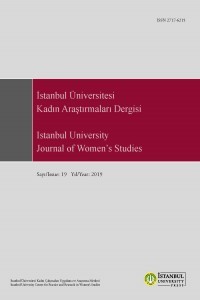OECD ÜLKELERİNDE ARAŞTIRMA GELİŞTİRME SEKTÖRÜNDE CİNSİYET EŞİTSİZLİĞİNİN İSTATİSTİKSEL ANALİZİ
Ekonominin tüm alanlarında olduğu gibi
araştırma sektöründe de cinsiyet yapısının analiz edilmesi kuşkusuz sektörün
gelişmesi için önemli bir fırsat sunmaktadır. Bu bağlamda çalışmamızda, OECD ülkelerinde
araştırma geliştirme sektörü için cinsiyet eşitsizliği istatistiksel tekniklerle analiz edilmiştir.Literatürü incelediğimizde araştırma
geliştirme sektöründe kadınların payının düşük olmasında, bireysel, sektörel,
bölgesel ve ulusal psiko-sosyo-ekonomik faktörlerin rol oynadığını
gözlemliyoruz. Araştırma geliştirme sektöründe kadın çalışanlarının payının
oldukça düşük olması bu alanda cinsiyet eşitsizliğinin göstermektedir.
Araştırma geliştirme sektöründe cinsiyet
eşitsizliğinin altında yatan sebeplerin ortadan kaldırılmasına yönelik
politikalar kadınların ve toplumun refahının artmasına katkı sağlayacaktır.
Anahtar Kelimeler:
Cinsiyet Eşitsizliği, Araştırma-Geliştirme, OECD Ülkeleri
STATISTICAL ANALYSIS OF GENDER INEQUALITY IN RESEARCH AND DEVELOPMENT SECTOR IN OECD COUNTRIES
As
in all areas of the economy, the analysis of gender structure in the research
sector is, of course, an important opportunity for the research and development
sector. In this context, gender inequality for the research and development
sector in OECD countries has been analyzed with statistical techniques. When we examine the literature, we
observe that individual, sectoral, regional and national psycho-socio-economic
factors play a role in the low share of women in research and development
sector. The fact that the share of female workers in research and development
sector is very low indicates that this gender inequality is in the field. Policies to remove the underlying causes
of gender equality in research and development sector will contribute to the
welfare of women and society.
Keywords:
Gender Inequality, Research and Development, OECD Countries,
___
- Baram-Tsabari, A., & Yarden, A. (2011). Quantifying the gender gap in science interests. International Journal of Science and Mathematics Education, 9(3), 523-550.
- Breakwell, G. M., & Robertson, T. (2001). The gender gap in science attitudes, parental and peer influences: Changes between 1987-88 and 1997-98. Public Understanding of Science, 10(1), 71-82.
- Carrell, S. E., Page, M. E., & West, J. E. (2010). Sex and science: How professor gender perpetuates the gender gap. The Quarterly Journal of Economics, 125(3), 1101-1144.
- Eccles, J. S. (2007). Where Are All the Women? Gender Differences in Participation in Physical Science and Engineering. In S. J. Ceci & W. M. Williams (Eds.), Why aren't more women in science?: Top researchers debate the evidence (pp. 199-210). Washington, DC, US: American Psychological Association.
- Fox, M. F., & Firebaugh, G. (1992). Confidence in science: The gender gap. Social Science Quarterly.
- Jagsi, R., Griffith, K. A., Stewart, A., Sambuco, D., DeCastro, R., & Ubel, P. A. (2012). Gender differences in the salaries of physician researchers. Jama, 307(22), 2410-2417.
- Legewie, J., & DiPrete, T. A. (2014). The high school environment and the gender gap in science and engineering. Sociology of Education, 87(4), 259-280.
- Shakeshaft, C. (1989). The gender gap in research in educational administration. Educational Administration Quarterly, 25(4), 324-337.
- Shen, H. (2013). Mind the gender gap. Nature, 495(7439), 22.
- Viadero, D. (2009). Researchers Mull STEM Gender Gap. Education Week, 28(35), 1-15.
- Yayın Aralığı: Yılda 2 Sayı
- Başlangıç: 2019
- Yayıncı: İstanbul Üniversitesi
Sayıdaki Diğer Makaleler
TÜRKİYE’DE CİNSİYET EŞİTSİZLİĞİNİN EĞİTİM, EKONOMİ, POLİTİKA VE SAĞLIK BOYUTLARI İLE İNCELENMESİ
II. DÜNYA SAVAŞINDA TÜRKİYE’DE GÖNÜLLÜ HEMŞİRELİK KURSLARI
ANTİK YAZARLARDA BİR ASSUR KRALİÇESİ: SEMİRAMİS
OECD ÜLKELERİNDE ARAŞTIRMA GELİŞTİRME SEKTÖRÜNDE CİNSİYET EŞİTSİZLİĞİNİN İSTATİSTİKSEL ANALİZİ
